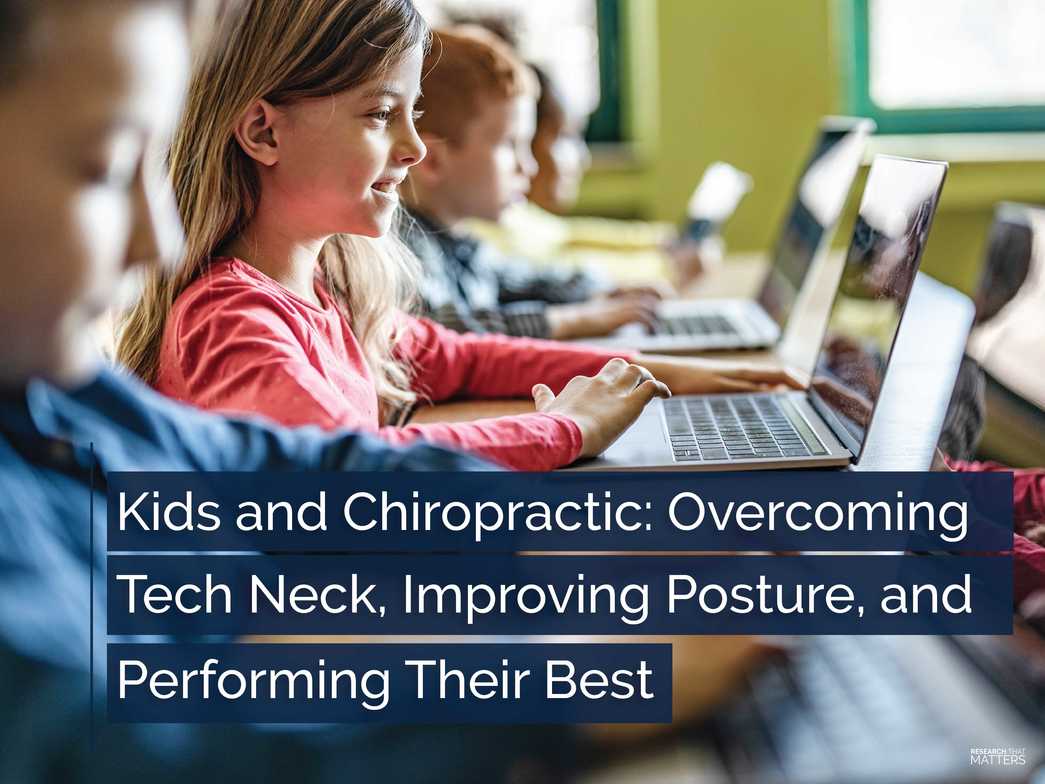
Be Smart With Your Smartphone and Look Up!
As education steps into the digital age, many students in Rochester, NY will be e-learning in some capacity for hours each day on their digital devices. While our devices can be fantastic tools for entertainment and education, the postural effects are something all parents should be aware of. For many students, e-learning may increase neck, mid-back, and low back pain.
Spending six or more hours each day looking down at your digital devices can profoundly affect your mental, social, and physical health. It can also lead to the development of "Tech Neck Syndrome". This forward head posture often places tremendous stress on the neck (cervical spine) and can lead to an uptick in headaches, back and neck pain, and more.
Did you know…
- Low back pain is the 3rd most common form of pain interfering with schoolwork.
- It's estimated that 50.3% of school-aged children present with posture disorders.
- Approximately 41.6% of children experience back pain from prolonged sitting.
E-Learning: How to Avoid Tech Neck
Is your child connected to a phone, computer, or tablet during and after school? Think about it. Many of us aren't more than an arm's length from our phone at any time (even when sleeping). Spending time every day looking down at our devices can place a lot of stress on the supporting muscles of our neck and lead to an uptick in headaches. It's a condition called "Tech Neck," one of the most common causes of headaches and neck pain.
The countless daily hours kids in Rochester, NY spend on phones and computers can significantly contribute to tension headaches. It’s estimated that kids spend up to 1,400 hours per year in the exact positions attributed to the development of "Tech Neck." That's not surprising. Recent research has also shown that even 15 degrees of forward head tilt can triple the weight of the head on the spine.
Here are some key things to remember when it comes to "Tech Neck"
- "Tech Neck" is the term used to describe the symptoms of headaches, neck pain, and poor posture attributed to the forward head posture often associated with using your phone, tablet, and computer
- Taking a break from our mobile devices every 15 minutes can help reduce the likelihood of developing recurring neck pain and headaches.
- Chiropractic care, including adjustments and postural exercises, can help decrease the pain and reverse the effects of "Tech Neck.”
Why Chiropractic Care is Critical for Kids Who Play Sports
Youth sports are a big deal. It's estimated that over 45 million kids are actively engaged in sports! While sports give kids a fantastic opportunity to grow socially and physically, they also increase risks for injuries, pain from overuse, and muscular imbalances. Finding proactive ways to reduce the risk of injury and balance the effects of training are essential for your child's developing musculoskeletal system. Sports injuries are a common reason for school kids to see a chiropractor in Rochester, NY.
Your child's skeletal system is actively developing until they are approximately 25 years old. Their postural habits, history of injuries, and genetics play a role in their body's final form (and function). Sports have the potential to add a significant amount of stress and increase the chances of injuries for your developing child. Even small injuries to their spine can create bigger challenges down the road as they get older. This is where your favorite Rochester, NY chiropractor comes in!
To recap:
- Addressing minor injuries and challenges while your child is young can help ensure proper musculoskeletal development.
- Youth sports can increase your child's likelihood of developing overuse, growth plate injuries, and chronic pain.
- Chiropractic care is a safe and natural way to help your child stay active and perform their best.
Power Your Child’s Brain with Movement
Years ago, many believed that the health benefits of exercise were limited to the body. However, research has demonstrated that regular physical activity and movement can benefit the body and the brain. Recent studies have highlighted that movement can improve the supply of oxygen to the brain and promote the production of new cells. It appears movement also aids in creating new connections in the brain!
Many schools have reduced physical education classes. Many more students have moved towards e-learning. For those reasons, it's important to be mindful of our children's physical activity and encourage them to exercise more daily. And not just to benefit their physical health. In many ways, exercising each day is likely to make your child a better student! Movement triggers the release of chemical substances in the brain that enhance brain function.
Here's a quick snapshot of the benefits of movement:
- Better Brain Function - Movement may protect your brain against degenerative changes.
- Better Stress Reduction - Exercise and movement have been shown to have an antidepressant effect that can help reduce overall stress.
- Better Memory - Regular exercise can help directly and indirectly improve recall and reasoning skills.
Next Steps:
Keep it simple. Encourage your children to take breaks and stretch often. These are some of the best (and easiest) ways to help them break the bad habits leading to "Tech Neck." If your child spends a lot of time online and begins experiencing neck pain or headaches, don't hesitate to give us a call.
Make sure you break up this screen time and sitting time with activity as well; remember that increased activity helps to promote growth and reduce stress! Regular chiropractic care at your favorite Rochester chiropractor can help your children move better and easier!
Our team is experienced in evaluating children and creating kid-friendly care plans. Our doors are open, and we're ready to help you and your family live the highest quality of life possible!
Science Sources:
Text Neck Syndrome. Intl Journal of Env Research and Public Health. 2021.
Back Pain in School Children. Dynamic Chiropractic. 1995.
School Children's Backpacks, Back Pain and Back Pathologies. Arch Dis Child. 2012.
Specialization & Overuse Injuries in Young Athletes. UCONN Health. 2017.
Learning Upregulates Neurotrophic Factor. Behavioral Neuroscience. 2019.
The Anti-Depressant Effect of Running. Intl Journal of Neuropsychopharmacology. 2005.
Regular Exercise Changes the Brain. Harvard Health Publishing. 2014.
How Exercise Affects Your Brain. Scientific American. 2018.
Assessment of Stresses in the Cervical Spine Caused by Posture. Surg Tech Intl. 2014.
Text Neck Syndrome. Intl Journal of Env Research and Public Health. 2021.
Three Steps to Build a Better Back. Harvard Health Publishing. 2015.



